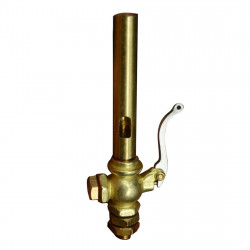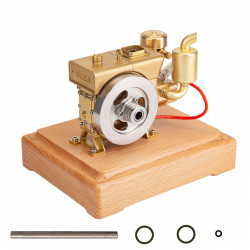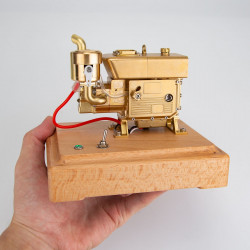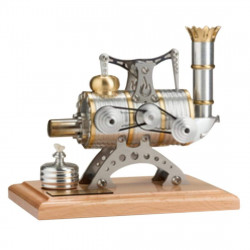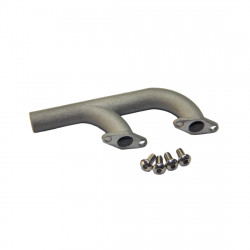
The Crankshaft: Backbone of the Internal Combustion Engine
How does the crankshaft work?
An essential component of an automotive engine is the crankshaft. Its job is to transform linear piston motion into rotating motion and the gas force from the piston and connecting rod into torque. Engineers utilize this torque to operate the car's transmission system, the engine's valve train, and other auxiliary devices. Simply put, it is the car's power output component.
In essence, the crankshaft is made up of several unit cranks. A unit crank consists of a crank pin, two left and right crank arms, and two left and right leading journals. The number of cylinders, their layout, and the engine's operation order all influence the position of the cranks.
The crankshaft's force is very intricate. It experiences bending and twisting loads. It works under the combined effects of changing gas force, inertial force, and its moment.
The journal must have enough surface area and wear resistance. The crankshaft also needs to be strong against bending, twisting, and fatigue.
Die forging is usually used to make crankshafts from 45, 40Cr, 35Mn2, and other medium carbon steels. The technicians treat the journal's surface with high-frequency quenching, nitriding, and finishing procedures.
To improve the crankshaft's strength and lower stress, it is recommended to shot peen the journal's surface. Rolling the rounded corners is also advised. We need to re-nitrid the crankshaft after grinding to prevent it from breaking.
Crankshaft fractures usually start with a small crack. These cracks are found where the crank arm connects to the head cylinder or end cylinder.
They occur at the fillet of the connecting rod journal. The crack progressively widens during the procedure and snaps at a given point. The bright, shiny tissue shows where the sudden rupture happened. The brown part is often seen on the broken surface, which is an old crack.
I'll tell you now the leading cause of the crankshaft breakage.
- The rounded corners at both ends of the crankshaft journal are too small.
The grinder improperly controlled the crankshaft's axial fillet during crankshaft grinding. The crankshaft's fatigue life was reduced by two factors.
First, the rough surface processing affected it. Second, the fillet radius was too narrow. This narrow radius caused a lot of stress at the fillet during operation.
- The offset of the crankshaft central journal axis
The offset axis of the leading journal destroys the crankshaft assembly's dynamic equilibrium. Crankshaft fracture is caused by a sizeable inertial force produced while the diesel engine operates at high speeds.
- The cold competition of the crankshaft is too large.
A significant bend will develop in the crankshaft after prolonged use, mainly due to burning tiles or crushing the cylinder. You should remove and fix this bend by cold pressing.
The metal inside the crankshaft will deform during calibration. This will create extra stress and weaken the crankshaft. The crankshaft may be broken or damaged if the cold competition is too great and will fail shortly after installation.
- The flywheel is loose
A loose flywheel bolt can make the diesel engine wobble after it runs. This can tire the crankshaft and increase the chance of it breaking at the back. It will also cause the crankshaft assembly to lose its original dynamic balance.
- Poor quality of the crankshaft itself
Crankshaft purchases should only be made from authorized sources; do not be avaricious and look for deals. Before installation, it should also be thoroughly inspected, and if there are any issues, they should be fixed or returned on schedule.
The technician should perform an oil immersion percussion check on the crankshaft. They should also conduct a magnetic fault test when servicing the engine. The crankshaft cannot be utilized again if the journal's surface has axial or radial cracks that reach the shoulder fillet.
- The main bush is different from the shaft.
When the crankshaft is put together, if the cylinder block's main bushes' centerlines are not aligned, it could quickly burn the bushes and hold the axles after the diesel engine runs. The crankshaft could also break from the intense action of alternating stress.
- The crankshaft assembly clearance is too large.
The crankshaft will strike the bearing bush after the diesel engine runs if there is excessive clearance between the crankshaft journal and the bush. This will cause the alloy to come off and burn to hold the shaft, and the crankshaft will also be more prone to damage.
- The oil supply time is too early, or the oil volume of each cylinder needs to be more balanced.
The diesel engine will make a loud noise if the fuel injection pump delivers fuel too early. This can burn the piston before it reaches the top dead center. The crankshaft journals will be unevenly stressed owing to the irregularity of the explosion cases of each cylinder if the fuel supply of each cylinder is not uniform, which may cause premature fatigue and cracks.
- Poor crankshaft lubrication
A worn-out oil pump, a dirty oil channel, uneven circulation, and low oil supply can lower oil pressure. This drop in pressure stops a proper lubricating oil film from forming between the crankshaft and the bearing bush. This will lead to dry friction, a burning bush holding the shaft, a broken crankshaft, and other serious accidents.
- The crankshaft broke after the operation.
Too much torque or shock load can damage the crankshaft. This can happen if the accelerator is too big or too small. It can also occur if you brake often or run the engine under stress for a long time. Moreover, diesel engine mishaps like flying and ramming the cylinder and top valve can easily break the crankshaft.
How to Diagnose Engine Crankshaft Fracture?
During maintenance, the following steps can be performed to keep the crankshaft from breaking:
Before any repairs, it is essential to ensure the crankshaft is free of cracks. In particular, the fillet transition should be thoroughly inspected. If someone finds a crack, they should discard the shaft.
When polishing the journal, keep a specific fillet radius on the journal and crank arm. Do not change the size of the fillet randomly. You must carefully maintain the fillet's surface polish; otherwise, stress concentration could lead to the crankshaft breaking.
Second, a method that has less impact on the journal's fatigue strength must be selected when the journal's size surpasses the limit. There is a significant decrease in intensity.
Then, every journal and bearing's matching and end clearance must meet the requirement. An excessive amount of clearance could make it easier for an impact to harm the crankshaft. A shaft break could result from an excessively tiny clearance in the crankshaft.
When assembling, make sure the ignition time is set correctly—not too early or too late. Also, check how the clutch, flywheel, and crankshaft balance.
A crankshaft replacement is a significant repair that takes a skilled mechanic at least one full day. The expense may be high if the issue is with the crankshaft itself. If a peripheral component is the source of the problem, you will spend less time and money.
